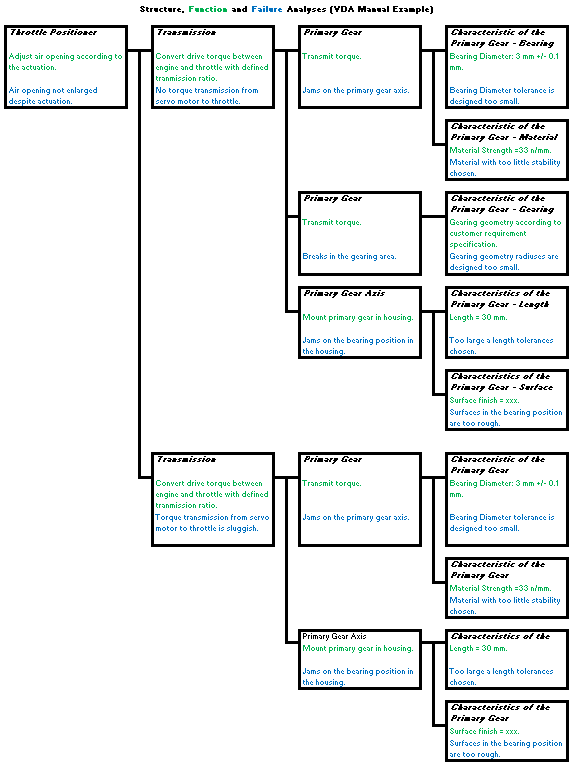
- VDA DESIGNS SOFTWARE
- VDA DESIGNS CODE
RPN: re-calculate Risk Priority Number after corrective action. Detection: re-evaluate detection capability after corrective action. Occurrence: re-evaluate occurrence possibility after corrective action.  Severity: re-evaluate severity of failure mode after corrective action. Actual Finish Date: The actual completion date. Target Finish Date: The plan completion date. Responsibility: Individual person or team/department who has to complete the recommended action. Action: Recommended action to eliminate or reduce the chance of the causes of failure mode. Depending on RPN and S, O, and D indexes, the responsible team/individual has to decide on the corrective action needed for each failure mode. RPN: (stands for Risk Priority Number) An indication number to evaluate the risk of the process based on Severity, Occurrence, and Detection. Detection ranks on a 1 to 10 scale, 10 means worst detection capability. Detection (D): a ranking number reflects the best detection control method. Detection Control (in Control Method) Design action to detect the failure or the cause of the failure if it happens. Occurrence ranks on a 1 to 10 scale, 10 means the highest possibility of occurrence. Occurrence (C): a ranking number reflects the possibility of occurrence of the Failure. Prevention Control (in Control Method): Design action to prevent potential causes to occur. A failure mode has one or many potential causes. Cause: The reason why failure happens. Class: Special product characteristic or high-risk failure mode.
Severity: re-evaluate severity of failure mode after corrective action. Actual Finish Date: The actual completion date. Target Finish Date: The plan completion date. Responsibility: Individual person or team/department who has to complete the recommended action. Action: Recommended action to eliminate or reduce the chance of the causes of failure mode. Depending on RPN and S, O, and D indexes, the responsible team/individual has to decide on the corrective action needed for each failure mode. RPN: (stands for Risk Priority Number) An indication number to evaluate the risk of the process based on Severity, Occurrence, and Detection. Detection ranks on a 1 to 10 scale, 10 means worst detection capability. Detection (D): a ranking number reflects the best detection control method. Detection Control (in Control Method) Design action to detect the failure or the cause of the failure if it happens. Occurrence ranks on a 1 to 10 scale, 10 means the highest possibility of occurrence. Occurrence (C): a ranking number reflects the possibility of occurrence of the Failure. Prevention Control (in Control Method): Design action to prevent potential causes to occur. A failure mode has one or many potential causes. Cause: The reason why failure happens. Class: Special product characteristic or high-risk failure mode. 
Severity ranks on a 1 to 10 scale, 10 is the most severe risk.
Severity (S): a ranking number reflects the most severe potential effect of a failure mode. Effects: Potential effects of the potential failure mode on the function and customers. A failure mode has one or many potential effects. Failure Mode: The way that an item potentially fails to meet the requirement. A requirement has one or many potential failure modes. Requirement: Requirements of a function. Items: Item (component, part, assembly) of the product/part to be analyzed. The information in the header can be customized to what you need to organize and control your document better. Revision Date: The latest revision date of FMEA. Original Date: The date that the original FMEA was compiled. Each organization should have a consistent document numbering system used for tracking the document. FMEA Number: The document control number of the FMEA document. Manager: Person who has responsibility for releasing the FMEA document. Responsible: Person who is responsible for preparing the FMEA document. Team: List of team members who are involved in the FMEA project. VDA DESIGNS CODE
Project (or Model): Enter the project code or model year used to distinguish the product and process being analyzed with similar.This could be a system, sub-system, or component. Product / Part: the object is being analyzed.

Let’s dive deeper into each FMEA Template. You should determine the analysis hierarchy structure and apply it consistently in all FMEA forms.Įach template has one or more different header items or columns depending on what is being analyzed (product, process, service, …) and the organization’s need. The information is listed in the columns with a hierarchy structure. Columns: The body of the template includes many columns.These pieces of information are normally necessary for quality management systems. Header: The upper part of the template is the header which includes general information on FMEA analysis and document and track information.1.5 hours per day with the necessary breaks to process what has been learned. A break of about 15 minutes is scheduled between the units. The blocks are made up of two units of approx. The contents are taught in blocks of 3 hours each (morning, afternoon). Use of e1ns.portal, e1ns.foundation, e1ns.architect, thods, e1ns.output und e1ns.dashdoard
VDA DESIGNS SOFTWARE
The use of the software is demonstrated and deepened through independent exercises on the PC. The possibilities in the use of the PLATO e1ns software and its application areas are taught. The introductory seminar is aimed at FMEA moderators, managers and team members who want to create and edit FMEAs using the PLATO e1ns software.







 0 kommentar(er)
0 kommentar(er)
